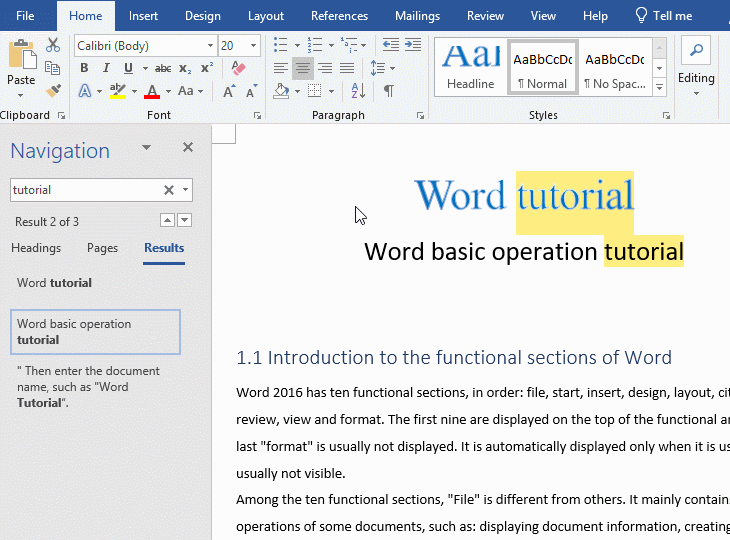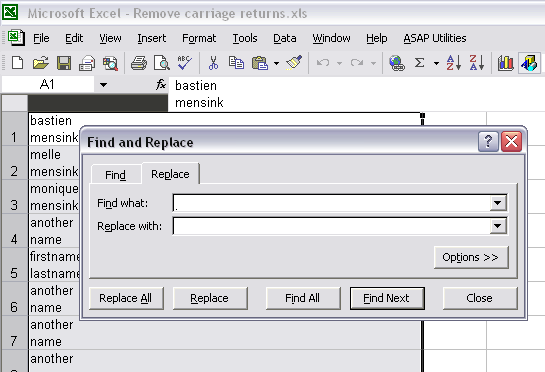
- MICROSOFT WORD FIND AND REPLACE A NEWLINE PRO
- MICROSOFT WORD FIND AND REPLACE A NEWLINE CODE
- MICROSOFT WORD FIND AND REPLACE A NEWLINE SERIES
Several of these special characters have a keyboard shortcut and a caret code. The table below lists the keyboard shortcuts and caret codes for finding and replacing the special characters listed above. Use Keyboard Shortcuts or Caret Codesįifteen special characters can be inserted into the Find and Replace dialog box using a keyboard shortcut and/or a caret code: Select the Close button to close the Find and Replace dialog box (see figure 7). Select the Replace, Replace All, or Find Next button (see figure 6).ĩ. Caret codes in the Find What and Replace With text boxesĨ.
MICROSOFT WORD FIND AND REPLACE A NEWLINE CODE
The caret code for the en dash appears in this example.) Figure 12. (Repeat step 5 and step 6 if you are replacing the existing character with one of the seven available in this dialog box. Enter the replacement character in the Replace with text box. The caret code for the em dash appears in figure 12, below.ħ. The special character will appear in the Find what text box as a caret code. Select the special character from the menu. (Skip to Step 5 if the Less button is already visible.) Figure 9. Place your cursor in the Find what text box in the Find and Replace dialog box. Select Replace in the Editing group (see figure 3).ģ. Select the Home tab in the ribbon (see figure 2).Ģ. To select special characters from within the Find and Replace dialog box:ġ.

Seven special characters can be inserted into the Find and Replace dialog box through the Special drop-down menu: Select Special Characters from within the Find and Replace Dialog Box
MICROSOFT WORD FIND AND REPLACE A NEWLINE PRO
Pro Tip: You can also copy ( ctrl + c) and paste ( ctrl + v) the twelve special characters mentioned above directly into the Find and Replace dialog box. Select the Close button to close the Find and Replace dialog box. Select the Yes and OK buttons to close those dialog boxes.ħ.
MICROSOFT WORD FIND AND REPLACE A NEWLINE SERIES
If you selected Replace All, a series of small dialog boxes will tell you how many replacements were made. Replace, Replace All, and Find Next buttons

(The copyright symbol appears in this example.) Figure 1.

Select the special character in your text. To insert special characters directly into the Find and Replace dialog box:ġ. Twelve special characters can be inserted directly into the Find and Replace dialog box by selecting the character: As user3251498 has pointed out, you must hit CTRL + H to bring up the Find and Replace dialog.Enter Special Characters Directly into the Find and Replace Dialog Box NB: These Replace options are not accessible via the Find interface in the Navigation sidebar that pops up when you hit CTRL+F. I do believe that section breaks are matched by m ("Page/Section break"), however. Neither ^l ("Manual line break"), ^n ("Column break"), will catch regular old newlines (like, the kind you enter when you press, well, the ENTER key.

If you're using Word's version of regular expression (regex/regexp) syntax (enabled by checking the box labeled "Use wildcards" in the Find and Replace dialog*), then newlines are matched by ^13 (which I suppose is equivalent to ^p, "Paragraph mark", which Find/Replace only accepts when "Use wildcards" is not selected. The answer (for those running later versions of Word) I'm running Word 2016, and the only alternative to the basic literal searching (with a few special character escapes) is "Wildcard" matching, which is. Unfortunately, it seems that Microsoft has since ditched regexp in favor of its own "Wildcard" syntax. According to this answer to a question on StackOverflow, Word versions '97-2013 used regular regexp syntax (pun intended).


 0 kommentar(er)
0 kommentar(er)
